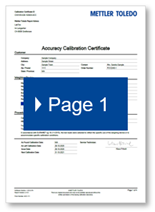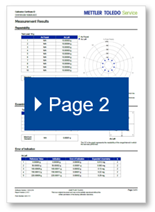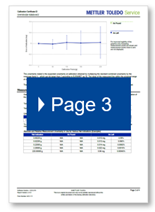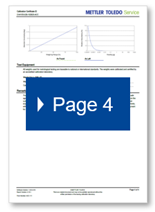Congratulations on purchasing the Accuracy Calibration Certificate (ACC) for your balance or scale. To leverage the full power of this calibration, please find details below on how to read the certificate page by page.

ACC Calibration Certificate Explanation
Leverage the Full Power of Your Calibration Certificate
Overview

Done: Calibration
The accuracy of weighing devices becomes less reliable over time and can therefore substantially impact your business success. Only an onsite calibration in the environment where the balance or scale is used allows you to determine how reliable your weighing results are.

Recommended: Fit-for-Purpose Check
Do you know how to assess your calibration results? The most important factor to consider is whether your balance or scale is fit for its intended purpose in terms of accuracy. Find out with the GWP® Certificate, available as an annex to the calibration. It compares the performance of your balance or scale to your specific weighing requirements.
 Some certificates look slightly different due to local accreditations or language versions. The content of the certificates, however, is always the same.
Some certificates look slightly different due to local accreditations or language versions. The content of the certificates, however, is always the same.
1 | Globally acknowledged: The ACC is set up according to the calibration guideline EURAMET cg-18, which ensures state-of-the-art compliance with the relevant regulations.
2 | As-found and as-left: The calibration certificate includes the assessment before (as-found) and after (as-left) any adjustment or repair. As-found calibration is important to determine if the validity of previous measurements has been adversely affected. It is a requirement defined in ISO/IEC 17025 and recommended in other standards. As-left calibration takes into account any adjustments made during maintenance. The different values are also portrayed on other pages for a simple overview of the device’s behavior – and full traceability.
3 | Do you know what your recommended calibration frequency is? If you need help defining your ideal calibration frequency, GWP Verification can help. Learn more
4 | Repeatability tests assess the ability of the instrument to provide the same results for the same weight applied multiple times – or how far these results deviate from each other.
5 | “d” stands for readability, also known as the smallest increment a device can display. For example, if the readability is 1 g, then 1d = 1 g; 2d = 2 g; etc.
6 | Eccentricity indicates the corner load deviations of the weighing device or the amount to which the measurement in the corner of the balance or scale deviates from the center.
7 | The Error of Indication shows how much the displayed value (“is”-value) deviates from the value of the calibration weight (“should”-value) at various measurement points.
8 | The uncertainty derived from calibration is multiplied by the coverage factor k to provide the expanded uncertainty. The coverage factor k is chosen such that the expanded uncertainty corresponds to a coverage probability of approximately 95%. For example, in line 2 of the table shown here, with a 95% probability the true value lies between 299.94 kg and 300.10 kg (indication +/- expanded uncertainty).
The statement of the expanded measurement uncertainty is an indispensable part of a calibration certificate. Without measurement uncertainty, the document is only a test report.”
9 | The coverage factor may differ for the individual error of indication measurement points. Furthermore, the more repeatability measurements are completed, the more information is available about the uncertainty, which allows the coverage factor k to be lowered (closer to 2).
10 | The uncertainty in use considers the real working environment during daily use as compared to the uncertainty at calibration, which is a snapshot of the device performance at the time of calibration. While not mandatory, it is an integral part of the ACC and essential to confirm the actual performance of the device during routine use. In addition, it acts as the basis for an assessment against the user’s weighing tolerance.
11 | The temperature drift is quantified by considering the presumed temperature range at the installation location between two calibrations and the temperature coefficient of the device. The temperature drift of the sensitivity has an impact on the measurement performance in routine use.
12 | Kelvin (symbol K) is the SI unit for the temperature. SI stands for the international system of units.
13 | This is the main result of the calibration certificate: the measurement uncertainty equation that applies to the routine use of the device (as-found and as-left). “R” stands for the reading, which reflects the mass of the applied object. For more concrete examples, see the table right below.
14 | Derived from the uncertainty equation (see point 13), this table shows examples of how big the measurement uncertainty is for different net indications (applied objects). This allows you to determine if the measurement uncertainty presented by the device meets your needs and industry regulations.
Do you need help determining if this is fit for your purpose? The GWP Certificate does a fit-for-purpose check on your calibration results.
15 | Traceability in calibration is the ability to trace the calibration results to a known reference standard.
16 | Identification of the weights that were used to perform the calibration; by means of the calibration certificate ID, traceability to the SI (International System of Units) is established.
Learn More
What Is Good Weighing Practice?
GWP® helps to ensure consistent quality, reduce costs and enable airtight compliance in any weighing process. Les mer
Your Individual Routine Testing Plan
Get your routine testing plan, including test frequency, methods, weights, and tolerances. Les mer
Webinar On-Demand: Measurement Uncertainty and Minimum Weight
Learn about what it is and how you can find out your measurement uncertainty and minimum weight. Les mer










